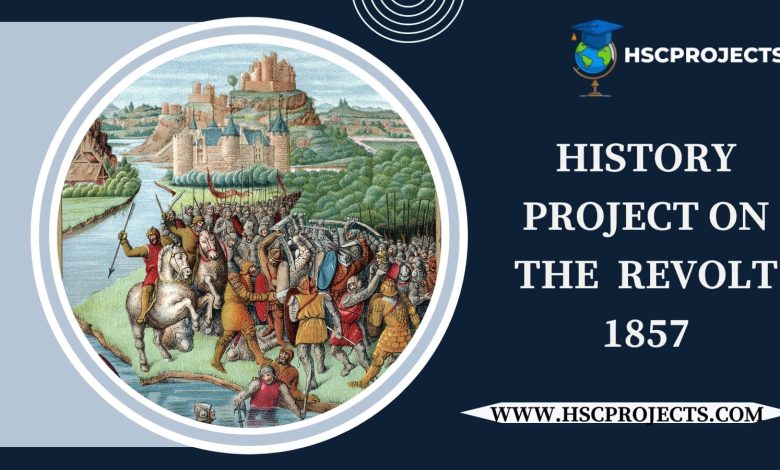
HISTORY PROJECT ON THE REVOLT 1857
ACKNOWLEDGEMENT:
I would like to express my special thanks of gratitude to my teacher—well as our principal—who gave me the golden opportunity to do this wonderful project on the topic of Marketing Managements which also helped me in doing a lot of research and I came to know about so many new things. I am really thankful to them.
Secondly, I would also like to thank my parents and friends who helped me a lot in finalizing this project within the limited time frames.
INTRODUCTION:
The Indian Rebellion of 1857 was a major but ultimately unsuccessful, uprising in India in 1857-58 against the rest of the British East India Company, which functioned as a south region power on behalf of the British crown. The rebellion began on 10 May 1857 in the form of a meeting of sepoys of the company’s army in the garrison town of Meerut, 40 Km northeast of Delhi. It then erupted into other mutinies and civilian rebellions chiefly in the upper gang etic plain and central India, though incidents of revolt also occurred further north and east. The rebellion posed a considerable threat to British power in the region and was contained only with the rebels defeat in Gwalior on 20 June 1858. On 1 November 1858, the British granted amnesty to all rebels not involved in murder, though they did not declare the hospitalities to have formally ended until 8 July 1859. Its name is contested, and it is variously described as the sepoy mutiny, the Indian mutiny the Great Indian Insurrection, and the first war of independence.

POLITICAL CAUSES:
1. British Policy of Expansion:
The British expanded their political power in India in four ways :
- By outright wars to expand their territory in India, the British fought many wars.
- System of subsidiary alliance card Wellesley introduced this system in which the Indian States were brought under British control without annexing them. Under this system
Indian rulers agreed to :
Accept the British as supreme power to end foreign relations and wouldn’t employ any weapon without consulting maintain British troops at their own cost, virtually lost Independence.
- The doctrine of lapse-lord Dalhousie annexed many Indian states using the Doctrine of lapse according to which heirs adopted without the consent of the company’s rule.
- On the pretext of alleged misrule, Lord Dalhousie annexed Awadh on 13 Feb 1856. British broke their promises given to ruling chiefs. People had a face more hardships, had to pay higher taxes and revenues, the problem of unemployment rose, the property was confiscated, 75000 sepoys were worst affected didn’t like what the British did in Awadh.
2. The Disrespect Shown To Bahadur shah :
Bahadur shah-A Mughal ruler was under the protection of the company but after his death, lord Dalhousie announced the winner widow Zeenat Mahal and successors can’t use Red fort as a palace and in 1956 lord canning announced that the successors can’t use imperial littles. This hurts the sentiments of Muslims.
3. Treatment given to Nana Saheb & Rani Laxmi Bai:
Baji Rao ll-the last Peshwa was under the protection of the company but after his death, they refused to pay. The grant to the ruler’s adopted son i.e. Nana Saheb. He was sent to Kanpur away from Poona.
4. Disrespect shown to Bahadur Shah:
He was a Mughal ruler, under the protection of the company but after his death, lord Dalhousie announced that the ruler’s widow Zeenat Mahal and successors can’t use Red Fort as a palace and in 1956 lord canning announced that the successors can’t use imperial titles.
SOCIO-RELIGIOUS CAUSES:
1. Interference With Social Customers :
Sati, Widow remarriage Act, western education to girls wasn’t welcomed by masses.
2. Apprehension About Modern Innovation – Railways & Telegraphs :
Indians misunderstood that telegraph poles were erect to hand them and in railways, castes were made to seat with lower castes.
3. Policy of Racial Discrimination:
Disrespect and Ill-treatment were given to Indians.
4. Corporation in Administration:
Rich was allowed to go away after a crime and the poor were looted & tortured.
5. Oppression of the poor:
Beating, torture and Imprisonment
6. Fear Regarding Western Education :
Pandits and Maulvis feared that it is done to convert their children to Christians.
7. Taxing religious places:
Lands belonging to temples and mosques.
ECONOMIC CAUSES:
1. Economic exploitation:
- Indian was forced to export cotton, silk at a cheaper rate to England.
- Forced plantation of indigo and Tea.
- Indians hand to accept ready-made British goods.
- Indian products had high import duties in England.
- The problem of unemployment increased
2. Drain Of Wealth:
Heavy duties killed Indian cottage Industries and Handicrafts. Raw materials were brought to England from the surplus revenues of Bengal and started looting India raw materials, resources and wealth. The transfer of wealth. The transfer of wealth from India to England from the surplus revenue.
3. Decay of cottage Industries and Handicrafts:
- Heavy duties killed Indian cottage Industries and handicrafts.
- Imposed British goods worsened their condition.
- Export of cotton and silk was ceased.
- Absence of royal buyers-princess, zamindars etc.
4. Growing Unemployment:
5. Poverty & Famines:
12 major famines, the British didn’t bother
6. Economic Decline Of Peasantry:
Peasants had to pay heavy taxes & land revenues.
7. Inhuman Treatment Of Indigo Cultivators:
Forced plantation of Indigo, other crops were destroyed if didn’t follow the orders and cattle when taken away as punishment.
MILITARY CAUSES:
1. Ill-Treatment Sf Indian Soldiers:
Indian soldiers were ill-treated, poorly fed and badly housed. Didn’t bother about their sentiments and didn’t allow them to keep the beard, wear turbans etc.
2. Lower Salaries:
Indian soldiers were paid eight times fewer salaries than British soldiers.
3. Deprivation Of Allowances :
The British empire was spread across the nation and soldiers had to serve in areas away from their homes without extra payment and additional Bhatla. A free post facility for sepoys was also taken off.
4. Fewer Chances Of Promotions:
All higher posts were reserved for the British. Indians soldiers had fewer chances of promotion. They couldn’t go above the post of a subedar.
5. General Service Enlistment Act:
It was considered taboo for Brahmin to cross the sea. Despite that British sent Indians overseas on duty Didn’t bother about the sentiments.
6. Larger Proportions Of Indians In The British Army:
In 1856, 2,38,000 Indian soldiers worked in the British army as compared to 45,322 British soldiers.
7. Faulty Distribution Of Troops:
Strategic important places like Delhi & Allahabad had no British armies and was held by only Indian soldiers. When England was busy fighting wars outside Indian soldiers, decided to strike the British.

MAJOR EVIDENCE FROM THE HISTORY:
CONSEQUENCES OF THE FIRST WAR OF INDEPENDENCE:
End Of The East India Company’s Rule:
Crown took over the charge from company secretary of state for India was appointed who reported to British Parliament.
Queen Victoria’s Proclamation:
1 Nov 1958 at Allahabad the transfer of governance was done. Lord canning became the first viceroy of India. Promised not to interview in social and religious matters would bring equality, pardon soldiers, best of Indian industries, etc.
End Of Mughals And Peshwas:
Bahadur Shah ll went to Yangon and Nana Saheb went to Nepal. Two foes of the British came to an end.
Relations With Princely Starts:
The policy of Annexation and doctrine of lapse were abandoned.
Policy Of Divide And Rule:
After 1858, the British started Divide and Rule policy. Caste against caste, princess against people and Hindu against Muslims.
Widening Gulf Between Hindus and Muslims:
British sowed seeds of hatred among Hindus and Muslims.
Racial Antagonism:
British believed that they were superior and maintained distance from Indians. Railways. Parks, hotels etc. had seats “ Reserved for Europeans only”.
Increased Racial Bitterness:
British believed chat Indians aren’t trustworthy and remodelled the structure of Indian government based on the idle superior races.
Religious Changes:
British rulers declared that they would not intervene in religious affairs, customs and traditions.
Foreign Policy:
India foreign policy was decided by the British with two aim :
- Protection of its Indian empire and
- Expansion of British economic & commercial interests.
Changes In The Army:
To avoid another uprising Indian army was reorganised after 1858 in the following manner :
- of Indian troops was decreased to 1,40,000 and no. of European troops was increased to 65,000.
- European troops were kept in key locations.
- The policy of excluding Indians from officer positions was strictly followed.
- Weapons were never placed under the charge of Indians.
- Soldiers weren’t allowed to read newspapers and journals.
Economic Exploitation:
- Indian became a colony to export raw material and import finished goods.
- Salaries of soldiers, military officers, council members were taken from Indians resources.
- Peasants were bankrupt/poor during British rule.
- Indian had to pay heavy taxes, revenues and dividend to British.
Rise Of Nationalism:
- The uprising of 1857, paved the way for the rise of the national movement.
- Sacrifices made by Rani Laxmi Bai, Nana Saheb, Mangal Pandey inspired Indians.
- Started a tradition of resistance to British rule.
DRAWBACKS OF FIRST WAR OF INDEPENDENCE:
- Lack of planning, organisation and leadership.
- Lack of common cause.
- Lack of participation from all sections of society.
- Lack of nationwide dimensions.
- Beginning of the movement before the fixed date (May 31, 1857).
CERTIFICATE:
This is to certify that class Xll, has completed his project under my school supervision. He has taken proper care and shown the utmost sincerity in the completion of this project. I certify that this project is up to my expectations and as per the guidelines issued by CBSE.
In order to download the PDF, You must follow on Youtube. Once done, Click on Submit
Follow On YoutubeSubscribed? Click on Confirm
Download HISTORY PROJECT ON THE REVOLT 1857 PDF






